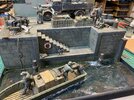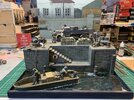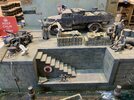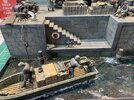Airborne01!
Active Member
- Joined
- Apr 22, 2025
- Messages
- 96
I can't compete with the foregoing masterpiece but this is my contribution: my 'Man Cave' has a series of modular Ikea display units composed of 'cubes' measuring 30x30x30 cms. At Christmas I was gifted many good things including an Itaeleri 'Dock with Stairs' which I thought would make a 'quick and dirty' diorama. It fits almost exactly into the cube once the books (which I'm in the process of selling) have gone, the problem is that the model and cube doesn't really lend itself to manipulation to allow forced perspective. I've called this 'Sitting on the Dock of the Bay' and it's not completed yet as it needs attention to the figures, some more minor details and the cleaning up of the base. I had to lash up a painted backdrop to give some idea of depth but essentially it needs viewing from straight ahead; C&Cs welcome!
Steve



Steve




Last edited:
